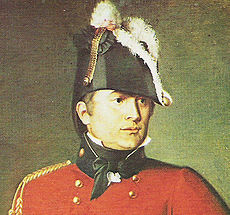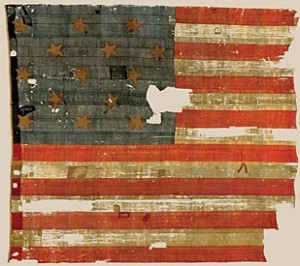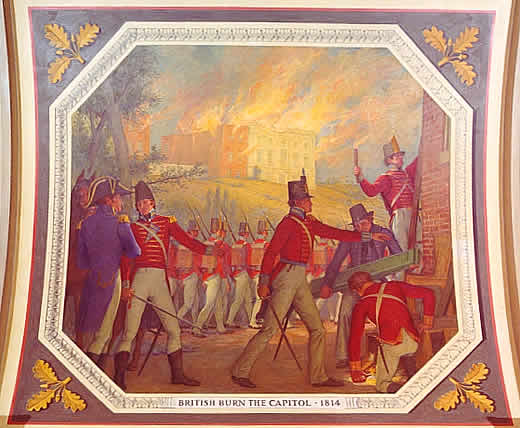A British soldier coming from Canada not only captured Washington, D.C., he also ignited the inspiration for “The Star Spangled Banner”. Then someone killed him. But who?
Who killed Major General Robert Ross? And furthermore, who cares?
Well, to start with, General Ross is distinguished as the only person in history who ever captured Washington, D.C. It was the War of 1812 and in retaliation for the invasion of Canada, Ross sacked and burned the U.S. capital. As a result, the Irish general’s family coat of arms now sports a hand clutching a broken staffed American flag.
Of interest to Canadians is that Ross’ historic invasion was partly launched from Nova Scotia, and to this day his body reposes in Halifax’s historic St. Paul’s Cemetery. Of further note is that those remains may hold answer to a medical forensic mystery that has long puzzled historians.
 Ross can also claim credit for the naming of the White House. After Washington, D.C. was burned, the blackened frame of the president’s residence had to be whitewashed, hence the new name for the presidential mansion. It is said that after the city was taken, General Ross sat down and consumed the dinner that had been set for President Madison!
Ross can also claim credit for the naming of the White House. After Washington, D.C. was burned, the blackened frame of the president’s residence had to be whitewashed, hence the new name for the presidential mansion. It is said that after the city was taken, General Ross sat down and consumed the dinner that had been set for President Madison!
As if this is not enough, Ross is indirectly responsible for the composition of the poem that forms the lyrics for the American national anthem, “The Star Spangled Banner”. After burning Washington, the British forces were returning to their ships when they captured a physician by the name of Dr. William Beanes. Beanes had detained some British stragglers during the Redcoats’ retreat. He was imprisoned on a British warship until President Madison asked a Georgetown lawyer named Francis Scott Key and U.S. Agent for Prisoners Col. John S. Skinner to secure his release.
 On September 7, Skinner and Key, the future author of “The Star Spangled Banner”, met with General Ross. The British commander agreed to allow Beanes’ release. During the British attack on Baltimore, Key and Skinner were put on board a ship of truce anchored eight miles from the city. These circumstances gave Key a bird’s eye view of the spectacular but unsuccessful attack on Baltimore.
On September 7, Skinner and Key, the future author of “The Star Spangled Banner”, met with General Ross. The British commander agreed to allow Beanes’ release. During the British attack on Baltimore, Key and Skinner were put on board a ship of truce anchored eight miles from the city. These circumstances gave Key a bird’s eye view of the spectacular but unsuccessful attack on Baltimore.
If Ross had rejected the Americans’ request to release Beanes, the lawyer would likely have been well away from the action. He may never have been inspired by “the rockets’ red glare” and “the bombs bursting in air” to write the poem, “The Star Spangled Banner”.
Unfortunately, General Ross did not have much longer to live. While advancing towards Baltimore on September 12th, 1814, the 48-year old officer was felled by a single shot to his thorax. Admiral Cockburn, in a letter to Ross’ brother, describes how “a Musket Ball…passed thro’ his Right Arm and entered his Right Breast.” A British surgeon is reported to have told American garrison physician, Dr. James McCulloh, that the projectile that killed Ross passed through both lungs.
A longstanding mystery is: who shot General Ross? Writer Christopher T. George relates the legend that two teenaged American militia riflemen named Wells and McComas got word that Ross was riding a white horse. Seeing an officer thus mounted they “fired simultaneously”, felling General Ross. The pair were subsequently cut down by British fire.
Since only one ball reportedly hit Ross, the reported “simultaneous” firing of the weapons allowed credit for the kill to be attributed to both soldiers. Although Wells and McComas were killed in the same action that claimed the British commander, it seems doubtful they were responsible for Ross demise.
For starters, in a later reminiscence, a Royal Navy lieutenant clearly describes “the dead general’s servant leading a magnificent black horse” that day. Casting further doubt on this account is that a Ross’ aide de camp is allegedly quoted as saying the general was killed by “a musket ball and buck-shot”.
The latter report is of somewhat dubious authenticity but if true it is a crucial clue. Riflemen such as Wells and McComas used a smaller projectile and did not load their guns with buckshot. This type of load would have been found in the muskets of militia such as the Independent Blues, a company of the Fifth Regiment, also present when Ross was killed. This unit is reported to have felled an officer who may well have been General Ross.
Another possibility suggested by George is that an errant British musket ball felled Ross. It is intriguing that Ross’ remains may hold the key to solving this mystery. If a forensic examination shows buckshot embedded in the skeleton, it would lend credence to the Independent Blues or some other militia unit armed with muskets having cut down the general.
On the other hand, a small rifle bullet or damage consistent with one, would support the theory that Wells and McComas, or at least a rifleman, carried out the deed. Finally if a larger, British issue ball is discovered, or if damage to the skeleton allows estimation of the size of the projectile, we might find out that poor General Ross was “fragged” by one of his own.
It is possible that, as with another commander killed in the Chesapeake, Ross was laid out in state for the review of his troops on board one of the warships. In any case, tradition has it that afterward Ross was transported back to Halifax, his body preserved in a barrel of rum for burial.
Christopher George and American archeologist Kathy Erlandson have suggested that an examination of General Ross’ body could be carried out to solve this forensic puzzle. There is a local precedent for this in that the Duc d’Anville’s remains were exhumed from Fortress Louisbourg in Nova Scotia and examined before being re-interred, revealing he had a brain tumor.
Indeed, one of Ross’ descendants has stated that they would have no aversion to their ancestor being respectfully disinterred. Alternatively, if the original surgeon’s report can be located with appropriate details, further examination of the remains may not be necessary. Whatever happens, I’ll let readers know the final chapter of this interesting historic saga.
(Special thanks to Christopher George for his help with this article.)
References
1. “Who Killed Robert Ross?” Monumentally Speaking… by Christopher T. George
2. Star Spangled Banner Web Site, prepared by the Armed Forces Collections, National Museum of American History, in cooperation with the Public Inquiry Mail Service, Smithsonian Institution 8/95
3. e-mail correspondence with Christopher T. George
Image Credits
A mural depicting the burning of the Capitol by the British Army led by General Ross. Mural by Allyn Cox,
Oil on Canvas, 1973-1974, located in the Hall of Capitols in the Capitol.
General Robert Ross, artist unknown
Historic American “Star Spangled Banner”



Thank you for your interesting article on General Ross. I am also a descendant and would love any further information.
Best
Cathleen
His last name was Washington, Washington D.C. is a place. The D.C. stands for district of Columbia.